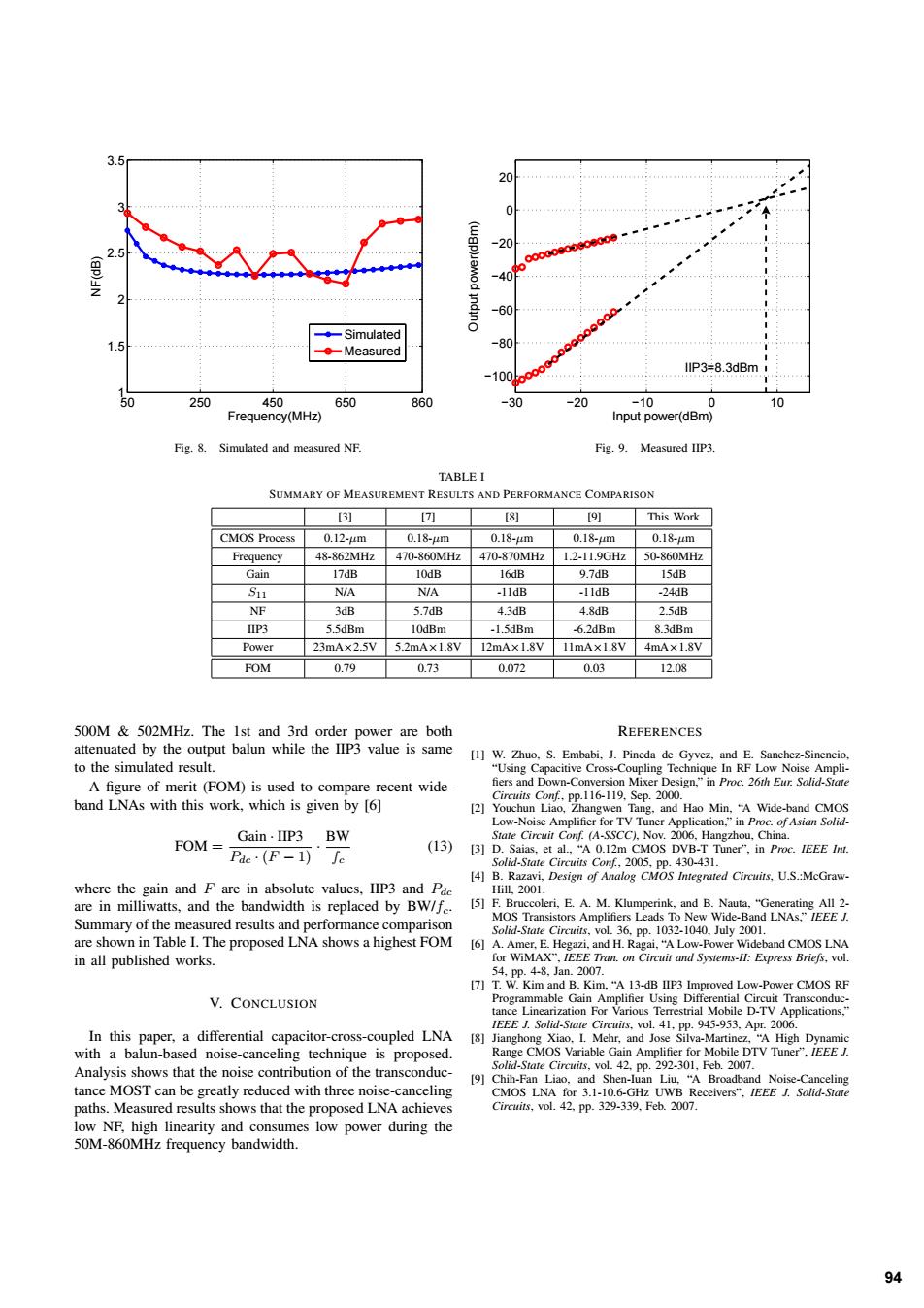正在加载图片...

20 0 20 40 60 6 ◆-Simulated 1.5 80 -Measured IIP3=8.3dBm .100 250 450 650 860 -20 -10 10 Frequency(MHz) Input power(dBm) Fig.8.Simulated and measured NF. Fig.9.Measured IIP3. TABLE I SUMMARY OF MEASUREMENT RESULTS AND PERFORMANCE COMPARISON [3) [8I 9 This Work CMOS Process 0.12-4m 0.18-m 0.18-4m 0.18-4m 0.18-4m Frequency 48-862MHz 470-860MHz 470-870MHz 1.2-11.9GHz 50-860MHz Gain 17dB 10dB 16dB 9.7dB 15dB S11 NIA NIA -11dB -11dB -24dB NF 3dB 5.7dB 4.3dB 4.8dB 2.5dB IIP3 5.5dBm 10dBm -1.5dBm -6.2dBm 8.3dBm Power 23mA×2.5V 5.2mA×1.8V 12mA×1.8V 11mA×1.8V 4mA×1.8V FOM 0.79 0.73 0.072 0.03 12.08 500M 502MHz.The 1st and 3rd order power are both REFERENCES attenuated by the output balun while the IIP3 value is same [1]W.Zhuo.S.Embabi.J.Pineda de Gyvez,and E.Sanchez-Sinencio to the simulated result. "Using Capacitive Cross-Coupling Technique In RF Low Noise Ampli- A figure of merit (FOM)is used to compare recent wide- fiers and Down-Conversion Mixer Design,"in Proc.26th Eur.Solid-State Circuits Conf,pp.116-119,Sep.2000. band LNAs with this work,which is given by [6] [2]Youchun Liao,Zhangwen Tang,and Hao Min,"A Wide-band CMOS Low-Noise Amplifier for TV Tuner Application."in Proc.of Asian Solid- FOM= Gain.IIP3 BW State Circuit Conf.(A-SSCC),Nov.2006,Hangzhou,China. Pac·(F-1)f (13)[3]D.Saias.et al."A 0.12m CMOS DVB-T Tuner".in Proc.IEEE Int. Solid-State Circuits Conf,2005,pp.430-431. 4]B.Razavi,Design of Analog CMOS Integrated Circuits.U.S.McGraw- where the gain and F are in absolute values.IIP3 and P HiL.2001. are in milliwatts,and the bandwidth is replaced by BW/fe. [5]F.Bruccoleri,E.A.M.Klumperink,and B.Nauta,"Generating All 2- Summary of the measured results and performance comparison MOS Transistors Amplifiers Leads To New Wide-Band LNAs,"IEEE J. Solid-State Circuits,vol.36.pp.1032-1040.July2001 are shown in Table I.The proposed LNA shows a highest FOM [6]A.Amer,E.Hegazi.and H.Ragai,"A Low-Power Wideband CMOS LNA in all published works. for WiMAX",IEEE Tran.on Circuit and Systems-II:Express Briefs,vol. 54,pp.4-8.Jan.2007. [7]T.W.Kim and B.Kim,"A 13-dB IIP3 Improved Low-Power CMOS RF V.CONCLUSION Programmable Gain Amplifier Using Differential Circuit Transconduc- tance Linearization For Various Terrestrial Mobile D-TV Applications. IEEE J.Solid-State Circuits,vol.41,pp.945-953.Apr.2006. In this paper,a differential capacitor-cross-coupled LNA [8]Jianghong Xiao.I.Mehr,and Jose Silva-Martinez,"A High Dynamic with a balun-based noise-canceling technique is proposed. Range CMOS Variable Gain Amplifier for Mobile DTV Tuner".IEEE J. Analysis shows that the noise contribution of the transconduc- Solid-State Circuits,vol.42.pp.292-301,Feb.2007. [9]Chih-Fan Liao,and Shen-luan Liu,"A Broadband Noise-Canceling tance MOST can be greatly reduced with three noise-canceling CMOS LNA for 3.1-10.6-GHz UWB Receivers",IEEE J.Solid-State paths.Measured results shows that the proposed LNA achieves Circuits,vol.42,pp.329-339.Feb.2007. low NF,high linearity and consumes low power during the 50M-860MHz frequency bandwidth. 9450 250 450 650 860 1 1.5 2 2.5 3 3.5 Frequency(MHz) NF(dB) Simulated Measured Fig. 8. Simulated and measured NF. −30 −20 −10 0 10 −100 −80 −60 −40 −20 0 20 Input power(dBm) Output power(dBm) IIP3=8.3dBm Fig. 9. Measured IIP3. TABLE I SUMMARY OF MEASUREMENT RESULTS AND PERFORMANCE COMPARISON [3] [7] [8] [9] This Work CMOS Process 0.12-μm 0.18-μm 0.18-μm 0.18-μm 0.18-μm Frequency 48-862MHz 470-860MHz 470-870MHz 1.2-11.9GHz 50-860MHz Gain 17dB 10dB 16dB 9.7dB 15dB S11 N/A N/A -11dB -11dB -24dB NF 3dB 5.7dB 4.3dB 4.8dB 2.5dB IIP3 5.5dBm 10dBm -1.5dBm -6.2dBm 8.3dBm Power 23mA×2.5V 5.2mA×1.8V 12mA×1.8V 11mA×1.8V 4mA×1.8V FOM 0.79 0.73 0.072 0.03 12.08 500M & 502MHz. The 1st and 3rd order power are both attenuated by the output balun while the IIP3 value is same to the simulated result. A figure of merit (FOM) is used to compare recent wideband LNAs with this work, which is given by [6] FOM = Gain · IIP3 Pdc · (F − 1) · BW fc (13) where the gain and F are in absolute values, IIP3 and Pdc are in milliwatts, and the bandwidth is replaced by BW/fc. Summary of the measured results and performance comparison are shown in Table I. The proposed LNA shows a highest FOM in all published works. V. CONCLUSION In this paper, a differential capacitor-cross-coupled LNA with a balun-based noise-canceling technique is proposed. Analysis shows that the noise contribution of the transconductance MOST can be greatly reduced with three noise-canceling paths. Measured results shows that the proposed LNA achieves low NF, high linearity and consumes low power during the 50M-860MHz frequency bandwidth. REFERENCES [1] W. Zhuo, S. Embabi, J. Pineda de Gyvez, and E. Sanchez-Sinencio, “Using Capacitive Cross-Coupling Technique In RF Low Noise Ampli- fiers and Down-Conversion Mixer Design,” in Proc. 26th Eur. Solid-State Circuits Conf., pp.116-119, Sep. 2000. [2] Youchun Liao, Zhangwen Tang, and Hao Min, “A Wide-band CMOS Low-Noise Amplifier for TV Tuner Application,” in Proc. of Asian SolidState Circuit Conf. (A-SSCC), Nov. 2006, Hangzhou, China. [3] D. Saias, et al., “A 0.12m CMOS DVB-T Tuner”, in Proc. IEEE Int. Solid-State Circuits Conf., 2005, pp. 430-431. [4] B. Razavi, Design of Analog CMOS Integrated Circuits, U.S.:McGrawHill, 2001. [5] F. Bruccoleri, E. A. M. Klumperink, and B. Nauta, “Generating All 2- MOS Transistors Amplifiers Leads To New Wide-Band LNAs,” IEEE J. Solid-State Circuits, vol. 36, pp. 1032-1040, July 2001. [6] A. Amer, E. Hegazi, and H. Ragai, “A Low-Power Wideband CMOS LNA for WiMAX”, IEEE Tran. on Circuit and Systems-II: Express Briefs, vol. 54, pp. 4-8, Jan. 2007. [7] T. W. Kim and B. Kim, “A 13-dB IIP3 Improved Low-Power CMOS RF Programmable Gain Amplifier Using Differential Circuit Transconductance Linearization For Various Terrestrial Mobile D-TV Applications,” IEEE J. Solid-State Circuits, vol. 41, pp. 945-953, Apr. 2006. [8] Jianghong Xiao, I. Mehr, and Jose Silva-Martinez, “A High Dynamic Range CMOS Variable Gain Amplifier for Mobile DTV Tuner”, IEEE J. Solid-State Circuits, vol. 42, pp. 292-301, Feb. 2007. [9] Chih-Fan Liao, and Shen-Iuan Liu, “A Broadband Noise-Canceling CMOS LNA for 3.1-10.6-GHz UWB Receivers”, IEEE J. Solid-State Circuits, vol. 42, pp. 329-339, Feb. 2007. 94